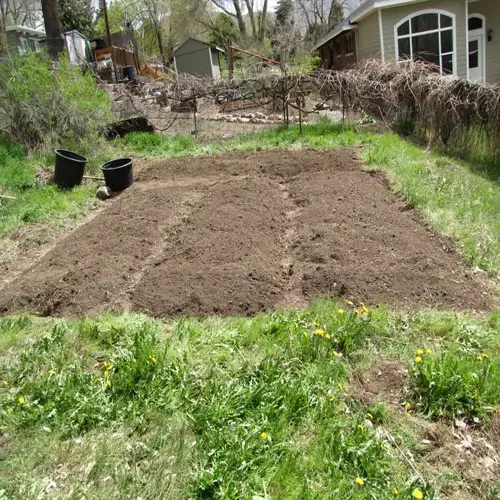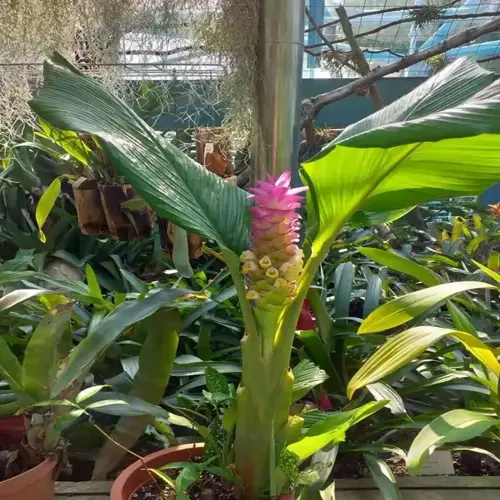How to Propagate Succulents: A Complete Guide

Written by
Julia Anderson
Reviewed by
Prof. Charles Hartman, Ph.D.Effectively propagate succulents by employing semi-mature leave and stem cuttings.
Callous the ends of your succulent cuttings for 3-7 days before planting to prevent your cuttings from rotting.
Use shallow trays filled with 2 inches of fast-draining soil.
During your succulents root developing stage, keep them in bright indirect light and mist sparingly.
Once roots have established, and the mother leaves are completely shriveled, you can transplant the pups.
Monitor any rotting or leggy growth, and adjust watering and lighting accordingly.
Article Navigation
Incredibly rewarding and satisfying, learning how to propagate succulents is priceless as you make new life from old plants. I still remember my first successful propagation, the joy of a tiny little root poking out of a single leaf. The entire process is miraculous and can rapidly grow your succulent garden in just two simple ways: one with leaf cuttings and the other with stem propagation.
It takes very little to start propagating succulents successfully. You can start with just a handful of healthy leaves or stem cuttings, soil, and a container. This method yields free plants and also teaches you the basics of gardening. When each new pup emerges from the ground as a result of your work, it makes beginner gardening even more enjoyable.
Essential Tools and Setup
You can start your succulent propagation journey with a shallow tray as a base. The tray will hold the special succulent soil mix that matters. Fill it 2 inches deep with a fast-draining blend of potting soil and perlite. The right depth will prevent the tray from becoming waterlogged, allowing the roots to grow. Your tray will turn into a nursery for new plants.
Leaf selection is the main factor determining your propagation success. Always choose plump, mature leaves near the base of the plant that break cleanly (not ripped or broken). Avoid leaves that are damaged or young, as they may not have stored sufficient energy yet. I will always evaluate each candidate under bright light, checking for firm texture, soft/hard, and uniform color. Healthy leaves drive the entire process.
The callousing phase introduces an element of local climate to the process. Dry areas can take up to 3 days for the cuttings to develop a protective skin. Humid areas can take up to 7 days to completely seal. Place leaves in a shaded and well-ventilated area. Please don't skip this step since it helps prevent decay later on. Good things come to those who wait, especially if you want a strong root system.
Leaf Selection Criteria
- Maturity requirement: Choose only plump, mature leaves from the lower part of the plant
- Health indicators: Select leaves with vibrant color and firm texture without spots
- Avoidance list: Reject wrinkled, immature, or pest-damaged leaves immediately
- Harvest technique: Twist gently side-to-side until cleanly detached from stem
- Quantity recommendation: Collect 10-15 leaves per propagation attempt
- Variety considerations: Some species like Aeoniums require stem cuttings instead
Preparation Process
- Drying duration: Allow 3-7 days for leaf ends to callous completely
- Humidity adjustment: Extend to 7-10 days in tropical climates
- Placement method: Arrange leaves on paper towels in single layer
- Location requirements: Keep in shaded, well-ventilated area away from direct sun
- Readiness test: Check for hardened, dry surface at detachment point
- Critical importance: Prevents moisture absorption that causes rot
Soil Mix Ratios
- Base composition: 3 parts standard potting soil to 1 part perlite by volume
- Drainage enhancement: Add coarse sand or pumice for heavy clay soils
- Moisture retention: Include coconut coir in arid environments
- Nutrient balance: Mix slow-release fertilizer into soil before planting
- pH considerations: Maintain slightly acidic soil between 5.5-6.5
- Container depth: Use 2 inches minimum for proper root development
Climate Zones
- Arid regions: Reduce watering frequency to every 4-5 days
- Humid areas: Increase air circulation with small fans
- Cool climates: Use heating mats to maintain 65-75°F (18-24°C)
- Seasonal adjustments: Shorten drying time in winter months
- Light variations: Provide supplemental lighting in cloudy regions
- Indoor setups: Rotate trays weekly for even light distribution
Sterilization Protocols
- Tool cleaning: Wipe shears with 70% isopropyl alcohol before use
- Tray sanitation: Wash containers with diluted bleach solution
- Soil treatment: Bake soil at 180°F (82°C) for 30 minutes
- Pest prevention: Inspect mother plants for insects before harvesting
- Fungal control: Apply cinnamon powder to calloused ends
- Cross-contamination: Use separate tools for diseased plants
Leaf Propagation Step-by-Step
To position callused leave(s), place them) so that the top side is facing up on the soil surface. This is important because the leaf base needs to make contact with soil, and the curved top needs light. Do not bury any of the leaves or anything. I like to picture them as little boats ready to set sail on growth. The proper position does promote root growth from those cells.
Modify your misting plan according to your local climate. Plants in dry climates will require light misting every two days to maintain moisture. Plants in humid coastal gardens may need misting every week at the most. Always check the soil's moisture level before adding water. Overwatering can drown delicate roots before your succulent pups become established. Here is where your skills of observation come in very handy.
Different varieties of succulents have different timelines. For instance, fast-growing plants like Sedum will have roots forming in 2 weeks, while slow-growing plants, such as Echeverias, will take about 6 weeks. Pups generally arise 3 weeks after rooting starts. It's always best to let the leaves develop without being disruptive. I have a propagation journal to track the growth rate of each species. Patience is rewarded when you see tiny little rosettes sprout.
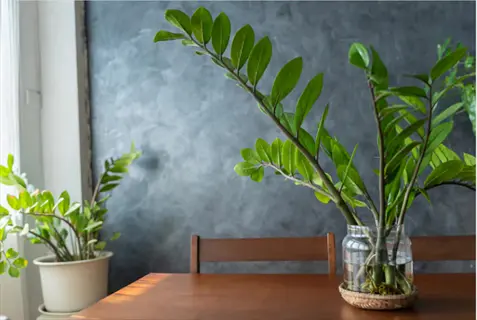
Calloused Leaves
- Appearance: Dry, hardened ends with no visible moisture
- Timeframe: Typically develops in 3-7 days after detachment
- Positioning: Lay flat on soil without burying the calloused end
- Climate adjustment: Extend to 10 days in humid coastal areas
- Failure signs: Soft or darkened ends indicate insufficient drying
- Success rate: 95% of properly calloused leaves develop roots
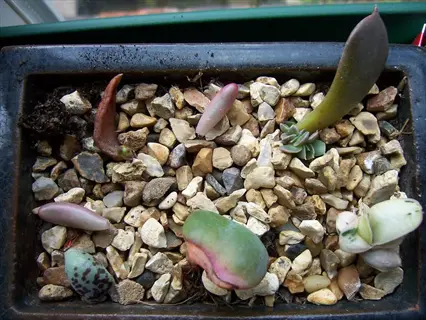
Root Development
- Initial signs: Pinkish tendrils emerging from calloused area
- Timeframe: Appears 2-4 weeks after placement on soil
- Moisture needs: Mist roots lightly when soil surface dries
- Growth pattern: Roots extend downward seeking moisture
- Common issue: White fuzzy mold indicates overwatering
- Solution: Reduce misting frequency and increase air flow
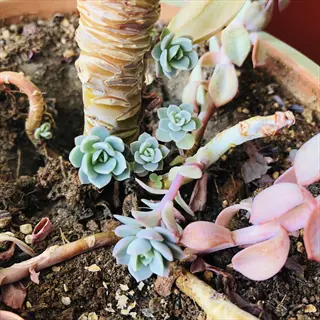
Pup Formation
- Initial signs: Miniature rosette emerging near leaf base
- Timeframe: Develops 3-6 weeks after root establishment
- Light requirements: Needs bright indirect light for coloration
- Growth rate: Doubles size every 2 weeks in optimal conditions
- Nutrition: Mother leaf provides all nutrients initially
- Warning sign: Stretched pups indicate insufficient light
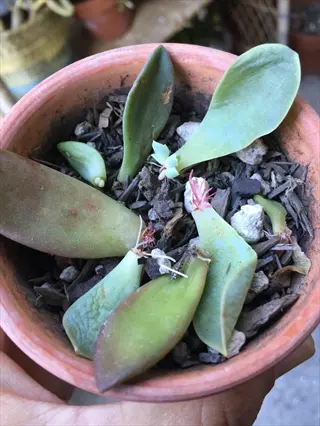
Mother Leaf Decline
- Natural process: Leaf wrinkles as resources transfer to pup
- Timeframe: Begins when pup reaches pea-sized diameter
- Separation: Gently twist when 90% shriveled and brittle
- Exception: Leave attached if pup growth seems stunted
- Salvage tip: Replant exceptionally large mother leaves
- Hygiene: Remove completely to prevent fungal issues
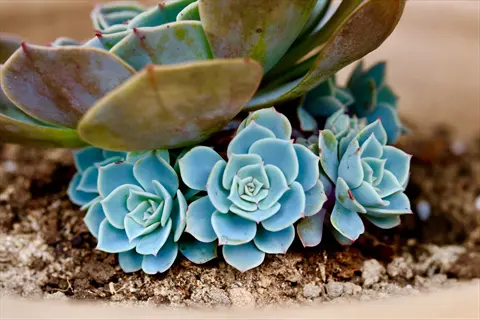
Established Pup
- Size indicator: Ready at 1 inch (2.5 cm) diameter with firm leaves
- Root system: White roots filling propagation tray section
- Transplanting: Gently lift with spoon to preserve roots
- Pot size: Use 2-inch (5 cm) containers with drainage holes
- Aftercare: Water thoroughly first week then reduce frequency
- Maturation: Reaches full size in 9-12 months
Soil Preparation
- Depth requirement: Fill tray with 2 inches (5 cm) of fast-draining soil
- Moisture level: Dampen evenly without creating puddles
- Composition: Use 3:1 potting soil to perlite mixture
- Surface texture: Gently flatten without compacting soil
- Tray type: Metal baking sheets provide ideal drainage
- Positioning: Place near east-facing window initially
Leaf Placement
- Orientation: Ensure leaf top faces upward at all times
- Spacing: Allow 1 inch (2.5 cm) between leaves for air circulation
- Contact: Rest calloused end lightly on soil surface
- Depth rule: Never bury any portion of the leaf
- Light exposure: Provide bright indirect light immediately
- Microclimate: Maintain 65-75°F (18-24°C) consistently
Moisture Management
- Initial phase: No watering until roots appear
- Misting technique: Spray soil surface until lightly damp
- Frequency: Every 2-3 days in arid climates
- Adjustment: Reduce to weekly in humid environments
- Sign of excess: Standing water or leaf discoloration
- Tool: Use fine-mist bottle held 12 inches (30 cm) above soil
Growth Monitoring
- Root checks: Lift leaves minimally to avoid damage
- Timeline: Expect roots in 2-6 weeks depending on species
- Pup development: Rosettes form 1-3 weeks after rooting
- Problem signs: Address mold immediately with airflow
- Documentation: Photograph weekly for progress tracking
- Patience note: Some varieties take 3 months to start
Transplanting Process
- Readiness cues: Mother leaf fully shriveled and detached
- Root handling: Preserve all root fibers during transfer
- Soil prep: Pre-moisten new potting mix before planting
- Depth: Set roots 0.25 inch (0.6 cm) below soil surface
- Aftercare: Shield from direct sun for first 7 days
- Watering shift: Transition to deep weekly watering
Stem Cutting Propagation
Stem cutting propagation is more effective than using leaf cuttings, especially for woody species. Leaf cuttings are reliable for 70% of species, while stem cuttings are reliable for 90% of succulents. The main difference is that the vascular system is present in succulent stems. I would recommend stems for new propagators due to their reliability.
Apply the beheading method to save stretched plants by cutting under the rosette. You will want to make a clean, 45-degree cut that leaves 1-2 inches of stem. This technique yields two plants: the top to replant and the base to continue growing zombie pups. I've used this method to save many leggy plants.
Stem cuttings need a shorter period of callousing than leaves, typically just 2 days. The thicker tissue seals quicker, which helps contain moisture on the inside. Always place at least one root node under the soil when rooting in soil. Specialized cells enable these nodes to grow roots faster compared to the bases of leaf cuttings, which produce roots more slowly.
Place the cuttings upright in the propagation tray, and gently firm the soil around the stems to secure them in place. Lightly water after planting, and then wait for the soil to dry before misting again. If all conditions are right, roots will form from the nodes within 10 days. This method is the most efficient way to expand your collection.
Cutting Selection
- Health indicators: Choose stems with plump, unblemished tissue
- Length requirement: 2-4 inch (5-10 cm) sections with 2+ nodes
- Timing: Early morning when plants are fully hydrated
- Tool prep: Sterilize shears with 70% isopropyl alcohol
- Angle technique: Cut at 45° to maximize rooting surface
- Exception: Avoid stems showing flower buds
Callousing Phase
- Duration: 3-5 days minimum in dry conditions
- Position: Place cuttings upright in empty container
- Climate factor: Add 2 days in humidity above 60%
- Readiness test: Hardened cut surface resists fingernail pressure
- Mistake alert: Never plant before full callousing
- Comparison: Requires less time than leaf callousing
Planting Technique
- Soil depth: Plant 0.5-1 inch (1.3-2.5 cm) deep
- Node rule: Bury at least one root node below soil
- Support method: Use chopstick for initial stabilization
- Soil mix: 2:1:1 potting soil-perlite-sand blend
- Density: Space cuttings 3 inches (7.6 cm) apart
- Watering: Light mist immediately after planting
Root Development
- Timeline: Visible roots in 10-21 days
- Temperature: Maintain 70-75°F (21-24°C) for optimal growth
- Light exposure: Bright indirect light for 14 hours/day
- Water schedule: Mist soil surface every 3 days
- Growth sign: New leaf emergence at stem tip
- Problem: Red stems indicate light stress
Beheading Method
- Application: For leggy plants with bare stems
- Cut height: 1-2 inches (2.5-5 cm) below rosette
- Stump care: Keep planted to produce 'zombie pups'
- Aftercare: Water stump lightly every 10 days
- Timing: Best performed in spring growth season
- Success rate: 90% when done on healthy plants
Caring for New Succulents
Succulent plant care after propagation is quite different from that of mature plants. Newly propagated plants have fragile root systems, so they require gentler care than established plants. I would not put them in a sunny location for about a month to allow them to develop roots as stress-free as possible. I graduate my propagations out of the shade, just as I do with my seedlings.
Keeping plants safe from harm by limiting stage-specific light. Start propagating in bright, indirect light and transition to morning sun after 2 weeks of this growing process. The optimal temperature is within the commonly acceptable range of 70-75°F for optimal plant growth. If it gets colder, heating mats can be used to provide additional warmth. Mature plants can tolerate a wider range, but baby plants require a narrower range.
Hardening off helps you avoid the biggest mistake during the transition phase. Start with 15 minutes of direct sunlight exposure, then gradually increase that each day over 3 weeks. Reduce the watering frequency to mirror a mature plant's schedule, at the same time. Abruptly making the transition causes sunburn or dehydration. I like to use my calendars to mark the days, so I remember how far I've progressed through the schedule.
Look for wrinkled leaves, which indicate underwater conditions, or translucent leaves, indicating overwatering. Check the soil moisture level to the root level before watering again. Propagated seedlings tend to require more care than the mature plant during their initial 8 weeks. Your observation is worth the vigorous growth you'll achieve in the future.
Light Management
- Acclimation: Increase direct sun exposure gradually over 2 weeks
- Indoor setup: Position under T5 grow lights 6 inches (15 cm) away
- Duration: Provide 14-16 hours daily for optimal growth
- Stress signs: Red edges indicate ideal light; brown spots mean sunburn
- Seasonal adjustment: Rotate plants weekly for even exposure
- Artificial lighting: Use 6500K full-spectrum LEDs for best results
Watering Technique
- Method: Bottom-soak for 20 minutes to encourage deep roots
- Schedule: Water when top 1 inch (2.5 cm) of soil is dry
- Container rule: Always use pots with drainage holes
- Water type: Filtered or rainwater prevents mineral buildup
- Dormancy care: Reduce to 1/4 volume during winter months
- Overwatering signs: Translucent leaves feel mushy
Soil and Nutrition
- Soil mix: 2:1:1 potting soil-perlite-coarse sand blend
- Repotting: Upgrade container size when roots circle current pot
- Fertilizer: Apply balanced 5-5-5 formula monthly in growing season
- Dilution: Use 1/4 strength for young plants
- Organic option: Worm castings provide slow-release nutrients
- Timing: Avoid fertilizing during dormancy
Temperature Control
- Day range: Maintain 70-80°F (21-27°C) during active growth
- Night drop: Allow 10-15°F (6-8°C) decrease for desert species
- Winter minimum: Protect from temperatures below 40°F (4°C)
- Heat stress: Provide shade above 95°F (35°C)
- Humidity management: Keep below 50% to prevent fungal issues
- Tools: Use heating mats in cool climates
Pest Prevention
- Common pests: Aphids, mealybugs, spider mites
- Prevention: Maintain airflow with small oscillating fan
- Treatment: Apply neem oil solution at first sign of infestation
- Application: Spray undersides of leaves weekly for 3 weeks
- Isolation: Quarantine new plants for 2 weeks
- Beneficial insects: Introduce ladybugs for aphid control
Troubleshooting Issues
Succulent rot shows up as mushy brown leaves, typically the result of being overwatered during propagation. This is generally caused by the soil remaining too wet for too long, or by cutting being planted before callusing has occurred. Remedy it right away by removing the affected areas and allowing the soil to dry out entirely. I begin by adding more perlite to the soil for drainage.
For best results, treat aphids in new growth with organic solutions first, then chemicals. A quick spray of water mixed with dish soap can easily dislodge the pests. To prevent reinfestation, apply neem oil every three days. If control is urgently needed due to large infestations, consider adding ladybugs as an additional control measure. First, completely isolate infected plants.
Leggy growth indicates not enough light intensity. Stretched stems indicate the extended area of your propagation needs more light. Slowly move cuttings closer to the light source. Rotating your plant daily during propagation ensures even light exposure. Beheading will produce compact and more even new growth, while also utilizing the long stems you cut off. This improves the initial shape.
The presence of white mold is a sign of excessive moisture around the cuttings. Increase airflow using small fans. Cut back on misting. A dusting of cinnamon powder on the soil will serve as a natural antifungal. When possible, space the plants slightly apart to help dissipate moisture more effectively. Your climate plays a role in how you prevent these issues.
Rotting Leaves
- Immediate action: Remove affected leaves and reduce watering
- Soil adjustment: Add 30% perlite to improve drainage
- Tool sterilization: Clean trays with 10% bleach solution
- Prevention: Extend callousing period to 7-10 days
- Recovery rate: 80% salvageable if caught early
- Last resort: Discard severely rotted specimens
Slow Root Development
- Light correction: Increase to 16 hrs/day under grow lights
- Temperature control: Maintain 75°F (24°C) with heating mat
- Hormone boost: Dip stems in rooting hormone solution
- Moisture check: Ensure soil surface dries between misting
- Timeframe: Roots typically appear within 14 days after correction
- Variety note: Echeverias root faster than Sedums
Leggy Growth
- Light solution: Move within 6 inches (15 cm) of light source
- Pruning technique: Behead stretched stems and replant tops
- Prevention: Rotate plants 90° daily for even exposure
- Light measurement: Ensure 2000+ lux at plant level
- Recovery time: New compact growth in 3-4 weeks
- Tool: Use light meter apps for accuracy
Fungal Issues
- Airflow fix: Add oscillating fan on low setting
- Natural treatment: Apply cinnamon powder to soil surface
- Water adjustment: Mist instead of soaking soil
- Humidity control: Keep below 50% with dehumidifier
- Spacing rule: Increase to 3 inches (7.6 cm) between leaves
- Chemical option: Use copper fungicide as last resort
Pest Infestations
- Immediate response: Quarantine affected plants
- Organic spray: 1 tsp neem oil + 1 quart (1L) water solution
- Application: Coat all surfaces including leaf undersides
- Frequency: Every 3 days for 2 weeks
- Preventative: Introduce ladybugs or lacewings
- Environmental: Avoid over-fertilizing that attracts pests
5 Common Myths
Any leaf of a succulent can propagate, no matter what the state of the leaf or how mature it is.
Only mature, healthy leaves from the lower part of the plant will propagate successfully. Young and damaged leaves don't have enough nutrients or auxins available to produce roots and pups. Professional propagators look for leaves that are fat and undamaged, and whose leaves detach cleanly at their base, but these leaves will also contain the meristematic tissue necessary for growth. Younger leaves typically do not survive propagation, and usually rot instead of rooting.
Watering succulent cuttings generously and daily promotes root growth and avoids dehydration while propagating.
Overwatering is the most common reason for propagation failure since too much moisture will not allow a callous to form, which increases the chance of fungal spores forming. The correct practice is to lightly mist the soil surface when it has dried entirely, typically attained every 3-5 days depending on humidity. When the roots are established, deep watering infrequently encourages downwards root growth, while cuttings with no roots should only receive moisture little by little to avoid rotting the slightly sensitive tissue.
The fastest propagation speed occurs during the direct exposure of the cutting to the most intense energy from sunlight for photosynthesis.
Propagation is best done in bright indirect light since prolonged periods of direct sun will create such a disturbance to the cuttings that they would develop dehydration before root development. Commercial and professional plant propagators will use a shade cloth of 40-50%, which diffuses the sunlight and keeps the air temperature of the environment well below 80°F (27C). East-facing windowsills will provide the most optimal morning light without the intensity that afternoon sun can bring. Artificial grow lights should also be positioned 6-12 inches (15-30 cm) above the cuttings, generating an intensity of 2000-3000 lux.
Rooting hormone is absolutely necessary for all succulent propagation methods to succeed.
Most common succulents like Echeveria and Sedum root naturally without hormones, which primarily benefit slow-rooting varieties like Haworthia. Professional propagators reserve hormone use for woody-stemmed cuttings or winter propagation when metabolic activity slows. Natural alternatives include cinnamon (antifungal) and aloe vera gel (root-stimulating auxins), while overuse can chemically burn delicate new root tissues.
Succulents propagated from pups will be reaching a mature size within weeks if the growing environment is ideal.
Succulents grow in a slow exponential curve and even in ideal conditions, it typically take succulents 6-12 months to reach mature size. In the first 3 months, newly propagated pups are typically focused on developing the roots and it will not produce physical leaf growth for a few months after the roots have a healthy base. Professional standards have shown that a pup that is 1 inch (2.5 cm) in size would typically take about 9 months to grow to 3 inches (7.6 cm) in size, with wide variability in growth rates to get to that size (e.g., a fast growing species like Graptopetalum may reach size before a slow growing species like Haworthia).
Conclusion
Succulent propagation provides simple and profound satisfaction as you create multiple plants from just a leaf or a stem. I delight in witnessing each pup emerge like a personal horticultural victory. This straightforward method is approachable enough to allow anyone to become a successful plant propagator with minimal work.
Begin with forgiving varieties, such as Sedum or Echeveria, for the most reliable initial success. These tough succulents are forgiving of beginner fails and will offer a few lessons to help develop foundational knowledge about care. I still have my first jade plant propagation after five years! Start small, and reward every root that forms!
Your growing experience lasts far beyond just free plants. Propagation becomes a gift that creates relationships with people through shared green offerings. Imagine gifting cuttings of your original plant, years later. The money saved by using a sustainable practice will make your plant parent experience more meaningful.
Each successful propagation represents improvement in your skills. Soon, they'll cover your shelves with propagated plants started from your own cuttings. Then the process can cycle around like a full circle as you share this knowledge, your garden nourishes your confidence.
External Sources
Frequently Asked Questions
What is the most effective method for propagating succulents?
The optimal approach uses mature leaf cuttings placed on well-draining soil:
- Select plump, healthy leaves from the plant's base
- Allow 3-7 days for callousing before positioning on soil
- Provide bright indirect light and minimal misting until roots form
Can succulent cuttings be planted directly in soil?
Planting un-calloused cuttings directly causes rot. Essential preparation includes:
- Let cut ends dry and harden for several days
- Ensure no open wounds remain before soil contact
- Plant only when the cut surface forms a protective seal
Is water or soil propagation better for succulents?
Soil propagation outperforms water methods significantly due to:
- Lower risk of rot from constant moisture exposure
- Natural root adaptation to growing medium conditions
- Easier transition to final planting without root shock
How long does root development take in new cuttings?
Root emergence timing varies by species and conditions:
- Fast-rooting varieties show growth in 2-3 weeks
- Slow species may require 4-6 weeks for visible roots
- Temperature and light quality dramatically influence timelines
Why are certain succulents illegal to propagate?
Protected varieties fall under intellectual property laws because:
- Patented hybrids require permission for reproduction
- Unauthorized cloning violates plant breeders' rights
- Endangered species have conservation restrictions
Do succulent propagations require direct sunlight?
Bright indirect light proves ideal during propagation stages:
- Direct sun scorches vulnerable cuttings without roots
- East-facing windows provide optimal gentle morning light
- Artificial grow lights positioned 6-12 inches above work effectively
Which succulents cannot be propagated from leaves?
Certain genera lack viable leaf propagation including:
- Sempervivums requiring offsets or stem cuttings
- Unique hybrids that don't produce genetic clones
- Species with fleshy leaves that decay before rooting
How can I accelerate root growth in cuttings?
Optimize environmental conditions for faster results:
- Maintain consistent 70-75°F temperatures
- Use rooting hormone on slow-developing varieties
- Ensure proper soil moisture without saturation
Can you replant succulents without existing roots?
Rootless specimens succeed with proper technique:
- Callous stem ends thoroughly before planting
- Bury at least one node beneath soil surface
- Provide stabilization with support sticks initially
When is the best season to propagate succulents?
Spring and early summer offer ideal conditions because:
- Active growth phases enhance root development
- Warmer temperatures accelerate metabolic processes
- Longer daylight hours support photosynthesis needs
